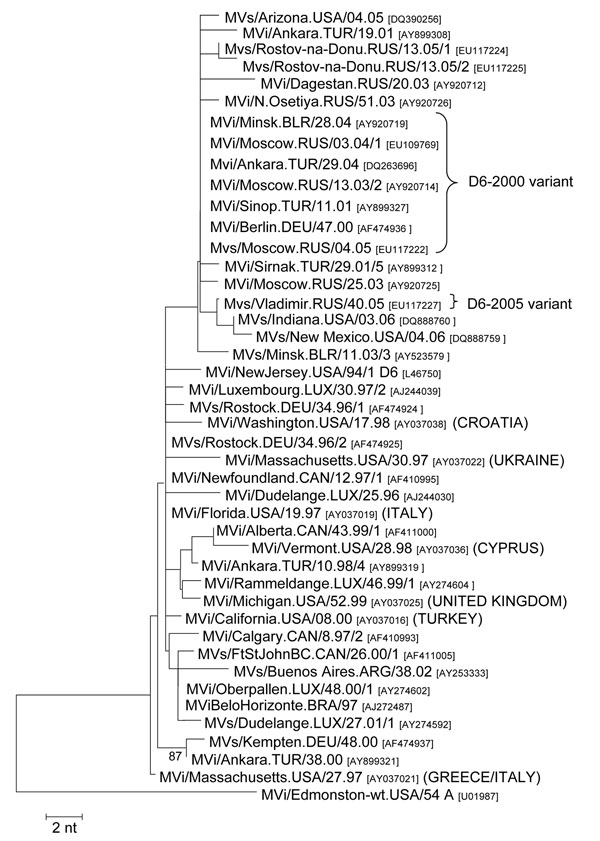High Genetic Diversity of Measles Virus, World Health Organization European Region, 2005–2006
Jacques R. Kremer*

, Kevin E. Brown†, Li Jin†, Sabine Santibanez‡, Sergey V. Shulga§, Yair Aboudy¶, Irina V. Demchyshyna#, Sultana Djemileva**, Juan E. Echevarria††, David F. Featherstone‡‡, Mirsada Hukic§§, Kari Johansen¶¶, Bogumila Litwinska##, Elena Lopareva***, Emilia Lupulescu†††, Andreas Mentis‡‡‡, Zefira Mihneva§§§, Maria M. Mosquera††, Mark Muscat¶¶¶, M.A. Naumova§, Jasminka Nedeljkovic###, Ljubov S. Nekrasova#, Fabio Magurano****, Claudia Fortuna****, Helena Rebelo de Andrade††††, Jean-Luc Richard‡‡‡‡, Alma Robo§§§§, Paul A. Rota***, Elena O. Samoilovich¶¶¶¶, Inna Sarv####, Galina V. Semeiko¶¶¶¶, Nazim Shugayev*****, Elmira S. Utegenova†††††, Rob van Binnendijk‡‡‡‡‡, Lasse Vinner¶¶¶, Diane Waku-Kouomou§§§§§, T. Fabian Wild§§§§§, David W.G. Brown†, Annette Mankertz‡, Claude P. Muller*, and Mick N. Mulders¶¶¶¶¶##
Author affiliations: *World Health Organization (WHO) Regional Reference Laboratory for Measles and Rubella, Luxembourg, Luxembourg; †WHO Global Reference Laboratory for Measles and Rubella, London, United Kingdom; ‡WHO Regional Reference Laboratory for Measles and Rubella, Berlin, Germany; §WHO Regional Reference Laboratory for Measles and Rubella, Moscow, Russian Federation; ¶Israel Ministry of Health, Tel Hashomer, Israel; #Ministry of Health, Kyiv, Ukraine; **Ministry of Public Health of the Republic of Uzbekistan, Tashkent, Uzbekistan; ††Instituto de Salud Carlos III, Majadahonda, Spain; ‡‡WHO, Geneva, Switzerland; §§University of Sarajevo, Sarajevo, Bosnia and Herzegovina; ¶¶Swedish Institute for Infectious Disease Control, Solna, Sweden; ##State Institute of Hygiene, Warsaw, Poland; ***Centers for Disease Control and Prevention, Atlanta, Georgia, USA; †††National Institute for Research and Development in Microbiology and Immunology “Cantacuzino,” Bucharest, Romania; ‡‡‡Institut Pasteur Hellenique, Athens, Greece; §§§National Centre of Infectious and Parasitic Diseases, Sofia, Bulgaria; ¶¶¶Statens Serum Institute, Copenhagen, Denmark; ###Institute of Virology, Vaccine and Sera Torlak, Belgrade, Serbia; ****Istituto Superiore di Sanità, Rome, Italy; ††††Instituto Nacional de Saúde Dr. Ricardo Jorge, Lisboa, Portugal; ‡‡‡‡Swiss Federal Office of Public Health, Berne, Switzerland; §§§§Institute of Public Health, Tirana, Albania; ¶¶¶¶Ministry of Health, Minsk, Belarus; ####Health Protection Inspectorate, Tallinn, Estonia; *****Ministry of Health, Baku, Azerbaijan; †††††Ministry of Health, Almaty, Republic of Kazakhstan; ‡‡‡‡‡Rijksinstituut voor Volksgezondheid en Milieu, Bilthoven, the Netherlands; §§§§§INSERM U404, Lyon, France; ¶¶¶¶¶WHO Regional Office for Europe, Copenhagen, Denmark;
Main Article
Figure 1

Figure 1. Phylogenetic tree showing representative genotype D6 strains identified in Europe before 2005, strains exported from Europe to other continents (source of exportation is shown in brackets), and the D6 variants that were dominant in Europe during 2005 (D6–2000) and 2006 (D6–2005). The phylogenetic tree was calculated on the basis of the 450 nt that code for the C-terminus of the MV N protein, by using MEGA 3.1 software and the neighbor-joining method (500 bootstraps). Genetic distances are represented as numbers of nucleotide differences between strains. Measles virus strains were named according to World Health Organization nomenclature: MVi/City of isolation.Country/epidemiologic week.year of isolation(/isolate number). Sequences obtained from RNA extracted from isolates (MVi) or clinical material (MVs) were distinguished. GenBank accession numbers are also shown for each strain.
Main Article
Page created: July 07, 2010
Page updated: July 07, 2010
Page reviewed: July 07, 2010
The conclusions, findings, and opinions expressed by authors contributing to this journal do not necessarily reflect the official position of the U.S. Department of Health and Human Services, the Public Health Service, the Centers for Disease Control and Prevention, or the authors' affiliated institutions. Use of trade names is for identification only and does not imply endorsement by any of the groups named above.
